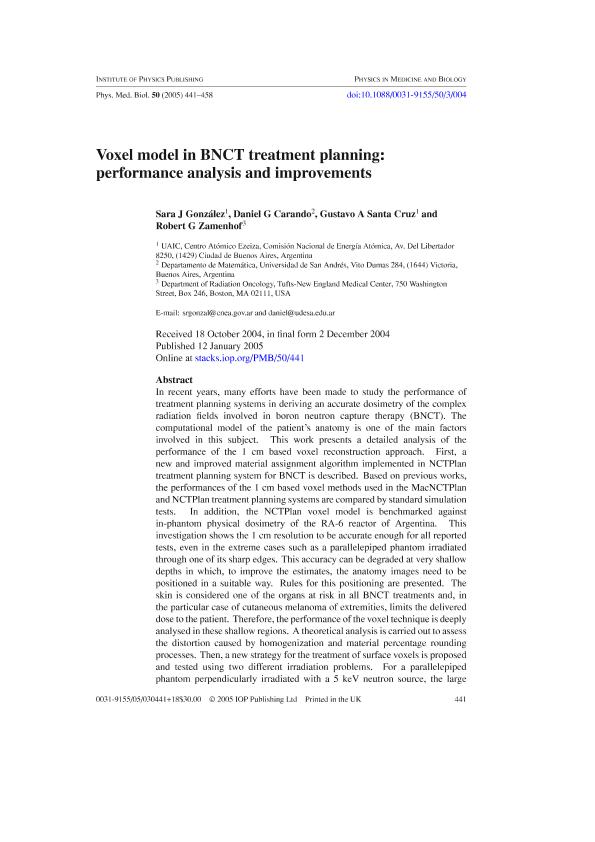Artículo
Voxel model in BNCT treatment planning: Performance analysis and improvements
Fecha de publicación:
01/2005
Editorial:
IOP Publishing
Revista:
Physics In Medicine And Biology
ISSN:
0031-9155
Idioma:
Inglés
Tipo de recurso:
Artículo publicado
Clasificación temática:
Resumen
In recent years, many efforts have been made to study the performance of treatment planning systems in deriving an accurate dosimetry of the complex radiation fields involved in boron neutron capture therapy (BNCT). The computational model of the patient's anatomy is one of the main factors involved in this subject. This work presents a detailed analysis of the performance of the 1 cm based voxel reconstruction approach. First, a new and improved material assignment algorithm implemented in NCTPlan treatment planning system for BNCT is described. Based on previous works, the performances of the 1 cm based voxel methods used in the MacNCTPlan and NCTPlan treatment planning systems are compared by standard simulation tests. In addition, the NCTPlan voxel model is benchmarked against in-phantom physical dosimetry of the RA-6 reactor of Argentina. This investigation shows the 1 cm resolution to be accurate enough for all reported tests, even in the extreme cases such as a parallelepiped phantom irradiated through one of its sharp edges. This accuracy can be degraded at very shallow depths in which, to improve the estimates, the anatomy images need to be positioned in a suitable way. Rules for this positioning are presented. The skin is considered one of the organs at risk in all BNCT treatments and, in the particular case of cutaneous melanoma of extremities, limits the delivered dose to the patient. Therefore, the performance of the voxel technique is deeply analysed in these shallow regions. A theoretical analysis is carried out to assess the distortion caused by homogenization and material percentage rounding processes. Then, a new strategy for the treatment of surface voxels is proposed and tested using two different irradiation problems. For a parallelepiped phantom perpendicularly irradiated with a 5 keV neutron source, the large thermal neutron fluence deviation present at shallow depths (from 54% at 0 mm depth to 5% at 4 mm depth) is reduced to 2% on average. Reassigning fluence values in the case of this phantom in angular position produced the maximum deviation in the thermal fluence to decrease from 140% to 23% at the surface of the phantom. Thus, even for the largest deviations, obtained by intentionally placing the phantom in the most disadvantageous position with respect to the voxel grid, the reassignment shows very good performance. Since these results substantially improve the performance of the 1 cm based voxel model in surface boundary regions, the proposed strategy will be implemented in future versions of the NCTPlan code.
Palabras clave:
Voxel model
,
BNCT treatment
Archivos asociados
Licencia
Identificadores
Colecciones
Articulos(IMAS)
Articulos de INSTITUTO DE INVESTIGACIONES MATEMATICAS "LUIS A. SANTALO"
Articulos de INSTITUTO DE INVESTIGACIONES MATEMATICAS "LUIS A. SANTALO"
Citación
González, Sara Josefina; Carando, Daniel Germán; Santa Cruz, Gustavo Alberto; Zamenhof, Robert G.; Voxel model in BNCT treatment planning: Performance analysis and improvements; IOP Publishing; Physics In Medicine And Biology; 50; 3; 1-2005; 441-458
Compartir
Altmétricas




